Thursday 1 October 2015
White: K. Nevols - Black: R Thompson (136)
After a gap of 21 years, I had at last rejoined a chess club - Swale Chess Club, based in Sittingbourne. After a couple of friendly games, I was asked to join the team and make my debut away to Snodland - which is a small town halfway between Rochester and Maidstone.
1. d4
In my youth, I started with d4. I spent a while flirting with e4 openings but decided I could not be bothered with all that French and Sicilian stuff.
1. ... Nf6
2. c4 g6
3. Nc3 d5
This is the Grunfeld defence, named after the Austrian player, Ernst Grunfeld (1893-1962), and was part of the 'hypermodern' trends of the 1920s. The idea is to allow White to occupy the centre with the intention of then attacking it.
4. cxd5
The Exchange variation - played because basically it is the only one I know. As this was my first over-the-board game for five years, I did ponder for a while about playing 4. Bf4 and e3 but best to stick to what you know. Some Karpov-Kasparov games featured 4. Qb3.
4. ... Nxd5
5. e4 Nb6
An unusual move. Normal is 5 ... Nxc3 6. bxc3 Bg7 to which I had intended Nf3 and Rb1.
I can't say I was too impressed with this move - the Knight has now moved three times. Looking at it afterwards, I think White now usually plays Be3.
(The computer likes 6. a4 a5 7. Bf4 Bg7 8. Nb5 with Rc1).
6. Nf3 Bg7
7. Be2 Bg4
Now I had a long think. Obviously there is a threat to d4 by Bxf3. I wrestled between three moves - 8. d5, 8. e5 and 8. Be3. After 8. d5, Black could play c6. Then perhaps 9. Nd4 Bxe2 10. Ndxe2 O-O 11. O-O or 9. O-O immediately. 8. e5 appealed for a while - blocking the Bishop and freeing up e4 for the Knight. Then 8 ... Nc6 9. Be3.
But in the end I decided I did not want to commit myself in the centre just yet so adding another defender to d4 while developing seemed to make sense.
8. Be3 h6?!
This move surprised me. White has no plans to go to g5 and can now stop Black from castling kingside.
9. Qd2 c6
Clearly Black was concerned about d5. I had half expected 9. ... Bxf3 after which I would have had to take back with the pawn as I did not like 10. Bxf3 Nc4 11. Qe2 (the only move to avoid losing a pawn) Nxe3 12. fxe3 (ditto) O-O with ideas like f5 or even c5.
10. b3
To stop any Nc4 ideas
10. ... e6
Now Black has committed himself in the centre I clamp my eyes on the d6 square for my Knight.
11. h3 Bxf3
12. Bxf3 N8d7
13. e5 Qe7
Being unable to castle kingside, Black has to shove his King the other way.
The time limits were 75 minutes for 35 moves and then another 15 minutes for the rest of the game - (thus each game would be over in three hours). I now had 46 minutes left for 22 moves and invested another nine here.
14. Ne4 O-O-O
I now had 37 minutes left for 21 moves. How time flies! My opponent said he was concerned about Nd6 for the next few moves but I could not see much in it. For example, 15. Nd6+ Kb8 and then what? I also had concerns over tactics regarding his captures on e5. Instead I concentrated on attacking the King and improving the position of my pieces. Unfortunately this also gives Black time to improve his defences
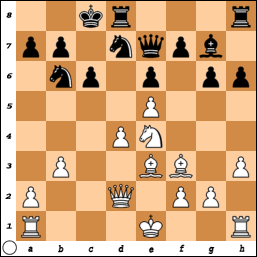
15. Qa5 Kb8
16. O-O Nd5
17. Bd2?!
I set on a rather dubious plan to save the black squared bishop and open the a-file but overlook his forthcoming defences.
(The computer considers this is a mistake and prefers Bc1 with the idea of Ba3, or simply an immediate Nd6. After 17. Bd2 Black can create space with f6 or c5).
17. ... N7b6
As I played 17. Bd2 it suddenly occurred to me that he had 17. .. b6. But it does not trap the Queen and I might profit from the weakening of the c-file.
18. a3 g5
I didn't understand this. Is he thinking of Nf4?
19. Bb4?!
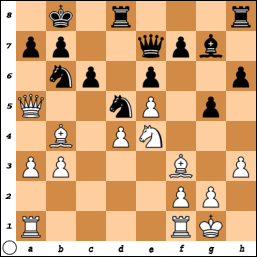
I think this is where I start to go wrong. Maybe Be2 with ideas of b4-b5. Or Nd6 and bring a rook to c1. The forthcoming sequence shores up his defences. I now have 25 minutes left for 16 moves.
19 ... Nxb4
20. axb4 Nc8
21. Nc5
He informed me that he was relieved to see this move and that the Nd6 threat was gone.
Looking at it now, I can't recall what I am threatening. After Rxd4, does Bxc6 bxc6, Na6+ lead to a perpetual check?
(Back to the computer who comes up with 21. b5 and if 21. ... cxb5 then 22. Rfc1 or of 21. .. Rxd4 22. bxc6. Had I seen this, I would not have wanted the d-pawn to go).
21. ... Qc7
22. Rfd1 Qb6
23. Rac1 Ne7
Now I am thinking of a draw. I have lost home of any thought of winning the position. His defences had been quite solid.
24. Qxb6 axb6
25. Ne4 Rd7
26. Nd6 Nc8
27. b5!
After a lot of thought. I could not see how I could defend the d4 pawn after Rhd8 and was pleased to find this move, the only one (I think) which holds.
27. ... cxb5
28. Nxb5
With this move, and a very well placed Knight, I offered a draw.
28. .. Rfd8
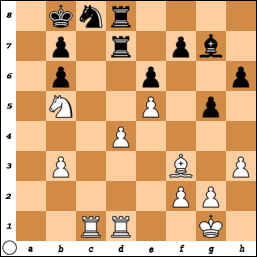
Unfortunately he declines and takes over the offensive. It was time to put on my 'grim defence' face, and I begin by bringing my King towards the centre, not realising that 29. Ra1! with Ra4 and Rda1 begins a powerful offensive.
29. Kf1? Bf8
30. Ke2 Ne7
31. Be4
To prevent Nf5.
31. ... Nd5
32. g3
To stop Nf4. You can see who has the initiative now!
32. .. Be7
33. Rf1?!
Preparing f4 to defend the e5 point. I did not want the d-file to be opened while those Rooks are standing there and the knight is doing a grand job of defending the d4 pawn. Unfortunately this sequence of moves allows the g-file to be opened instead.
I was conscious of possibilities of using the c7 square but only had the Knight in mind. Now I look at it, a possible sequence could be 33. Bxd5 Rxd5 34. Rc7 aiming to exchange one of the rooks. For example, 34. ... R5d7 35. Rxd7 Rxd7 36. Ke3 f6 37. exf6 Bf6 38. Rd3. The centre would still be under pressure but a draw is more likely.
A better line for Black might be 34. .. Rxb5 35. Rxe7 Rxb3 36. Rxf7 Rb4 37. Ke3 where he has a passed pawn but I have pawn chomping possibilities on the kingside
If 33. Bxd5 exd5 the centre is blocked and I have a pawn majority on the kingside.
33. ... f6
34. f4 f5
35. Bh1
Made the time control with five minutes left - now I had an extra 15 minutes to finish the game. I could foresee that the g-file was about to be opened and did not want the Bishop stuck on g2. I gave much thought to the line 35. Bxd5 Rxd5 36. Nc7 Rxd4 37. Nxe6 Rd2+ 38. Ke1 Rd3 with Bb4 to come - and decided I didn't like it.
35. ... gxf4
36. gxf4 Rg8!
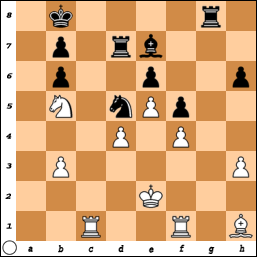
The correct winning plan and now I have to think again.
37. Kf3 Bb4
I could see 37. .. Nxf4 38. Kxf4 Bg5 39. Kf3 Bxc1 40. Rxc1 but decided I might get away with it. The Bishop diagonal is now open and I have the option of Nd6 (again).
38. Rc2
To stop Bd2 - although 38. Rg1 would have defended the g-file.
38. ... Rdg7
39. Ke2
Now I am thinking of snaffling the Knight as the Rook is no longer there to protect it.
39. .... Rg3
By now everyone else had finished their game and were hovering around my board. I heard we were 3-2 up which meant that if I could hold the draw, we would win the match. But if I lost, we would draw 3-3. This was my first match for Swale Chess Club!!
40. Bxd5 exd5
Now I had outside chances of running the e-pawn for a swindle.
41. Rf3 Rg1
42. Nc3
This Knight has worked very hard this game and now returns for one more duty - to block the e1 square.
42. ... Rh1
42. ... R8g2+! gives a better chance of winning. If 43. Rf2 Rg3 and then either 44. Rf3 Rg2+ or 44. Kd2 Rxc3 45. Rxc3 Rg3 would win.
If 43. Kd3 Rg3 and then 44. Rxg3 Rxg3+ 45. Kd2 Rxh3 would win - but I have not yet found a way for Black to force a win after 44. Ke3 and the d5 pawn still hangs.
43. Kd3 Bxc3
44. Rxc3 R8g1
Now if I can hold the second and third ranks I should be OK.
45. Rc2 Rd1+
46. Kc3 Rhg1
With thoughts of h5-4 and Rg3.
47. Rd2 Rde1
48. Kd3 Rb1
49. Kc3 Rgc1+
50. Rc2
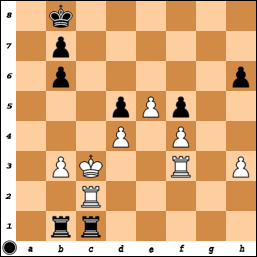
At this point, my opponent gave up pressing and offered a draw. A satisfactory result after a tough battle.

No comments:
Post a Comment